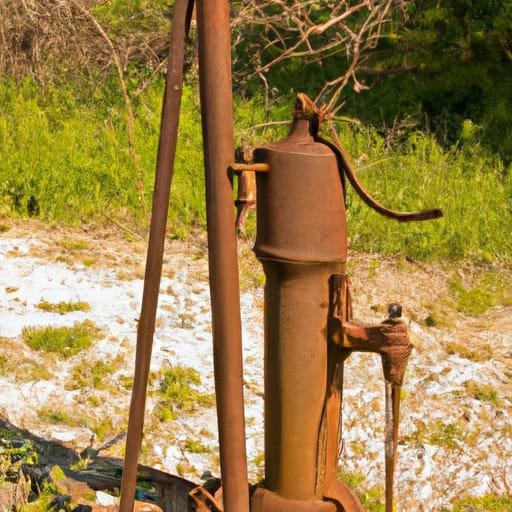Are you searching for ways to enhance the supply and storage capacity of your well water? Look no further! In this article, we will explore various techniques and strategies that you can employ to improve the overall efficiency of your well water system. From implementing innovative storage solutions to optimizing your well’s performance, we will provide you with practical tips that will ensure an abundant and reliable water supply for your household. So, if you’re ready to take your well water system to the next level, let’s dive in!
Install a larger well pump
Installing a larger well pump can significantly improve your well water supply and storage capacity. The first step in this process is to calculate your water demand. Consider your household’s water usage patterns and the number of occupants. Take into account factors such as bathing, cooking, laundry, and outdoor water usage. This calculation will help you determine how much water you require on a daily basis.
Once you have calculated your water demand, it is essential to select an appropriate pump size. A pump that is too small may not be able to meet your water demand, while a pump that is too large may lead to unnecessary energy consumption. Consult with a professional to determine the right pump size based on your water demand and well specifications.
Installing a larger well pump is not a DIY project and requires expertise. It is important to contact a professional for the installation process. A licensed well contractor or plumber can ensure that the pump is properly installed, connected to the well system, and functioning effectively. Their expertise will minimize the risk of any damage or inefficiency during the installation process and ensure a reliable water supply.
Implement a rainwater harvesting system
In addition to a well pump, implementing a rainwater harvesting system can augment your water supply and storage capacity. The first step is to assess the rainfall patterns in your area and determine the potential collection area. Consider the average annual rainfall, the roof surface area, and other surfaces where water can be captured, such as paved driveways or gardens.
Once you have assessed the rainfall patterns and potential collection area, choose suitable collection methods. Rooftop collection through guttering, downspouts, and diversion systems is a common method. You can also collect surface runoff from paved areas or landscaped surfaces. Each collection method has its advantages and limitations, so consider the characteristics of your property and choose accordingly.
Installing guttering, downspouts, and diversion systems is crucial to direct the captured rainwater into storage. Ensure that these systems are properly installed and regularly maintained to prevent any blockages or leaks. It is also essential to consider storage options for the collected water. Tanks or cisterns are common choices. Select the appropriate size and material based on your water demand and storage capacity requirements.
Furthermore, ensure proper filtration and treatment of the collected rainwater. Implement filtration systems to remove any debris or contaminants. Depending on the quality of the collected rainwater and its intended use, consider additional treatment methods such as disinfection or purification. Proper filtration and treatment will guarantee the safety and quality of the stored rainwater for various household purposes.

Construct a larger water storage tank
To further increase your water storage capacity, constructing a larger water storage tank is an excellent option. However, it is crucial to determine your required storage capacity before embarking on construction. Consider factors such as your water demand, the frequency and intensity of drought periods in your region, and your desired self-sufficiency level.
Once you have determined the required storage capacity, choose the appropriate tank material. Concrete and plastic are common choices with their respective advantages and limitations. Consider factors such as cost, durability, and compatibility with your water supply system. Additionally, decide whether you prefer an above-ground or underground tank, depending on the available space and aesthetic preferences.
Regardless of the tank location, proper insulation is crucial to minimize heat gain or loss. Insulation will prevent water from freezing in cold climates and minimize the energy required for heating or cooling the stored water. Additionally, ensure the tank is protected against contamination, such as by installing secure lids and implementing appropriate filtration systems.
Optimize existing well performance
If you already have a well, optimizing its performance can significantly improve your water supply and storage capacity. Regular maintenance and inspections are essential to ensure the well’s integrity and functionality. Inspect the well casing and seals for any signs of damage or deterioration. Address any issues promptly to prevent water leakage or contamination.
Cleaning and disinfecting the well should be done regularly to remove sediment, bacteria, and other contaminants. Consult with a professional to determine the appropriate cleaning frequency and methods for your specific well. Regular maintenance will ensure that your well continues to provide clean and safe water for your household.
To evaluate and improve your well’s efficiency, it is advisable to seek professional assistance. A hydrogeologist or water management expert can conduct a thorough assessment of your well system. They can identify any inefficiencies, recommend improvements, or suggest techniques such as well deepening or hydrofracturing if necessary.

Upgrade water distribution system
To optimize your water supply, it is essential to evaluate and upgrade your water distribution system. Assess your current pipes and fittings for any leaks, corrosion, or deterioration. Even small leaks can lead to significant water loss over time. Address any issues promptly by repairing or replacing damaged or aging pipes.
Consider installing a pressure tank or booster pump to improve water flow and pressure throughout your plumbing system. These devices can ensure consistent water supply, especially during high-demand periods or with multiple fixtures in use simultaneously. Consult with a professional to determine the appropriate size and type of pressure tank or booster pump for your specific needs.
Additionally, ensure that any water treatment devices in your distribution system are properly maintained. Filtration systems, water softeners, or UV disinfection units should be regularly serviced according to the manufacturer’s instructions. Proper maintenance will ensure the effectiveness of these devices in improving water quality and preventing any potential health risks.
Implement groundwater recharge methods
Groundwater recharge methods can help replenish your well water supply and storage capacity. Start by assessing the suitability of your site for different recharge techniques. Consider factors such as soil type, vegetation, and the presence of surface water or drainage systems. This evaluation will determine the most suitable method for your property.
There are various groundwater recharge methods to choose from, such as infiltration trenches or ponds. Infiltration trenches involve excavating trenches filled with highly permeable material to allow rainwater or surface runoff to infiltrate into the groundwater. Ponds can be used to capture and store excess water during wet periods, allowing it to slowly percolate into the aquifer.
Design and construct the chosen recharge system according to professional guidelines and local regulations. It is essential to ensure that the system is properly designed to prevent any potential contaminants from entering the groundwater. Regular monitoring and maintenance are crucial to ensure that the recharged groundwater remains clean and free from pollution.

Explore water-conserving technologies
Implementing water-conserving technologies can help reduce your water demand and enhance your overall water supply and storage capacity. Install low-flow fixtures and appliances throughout your household. These devices limit water flow without compromising functionality, resulting in significant water savings.
Consider implementing a gray water recycling system. Gray water is the relatively clean wastewater generated from sources such as sinks, showers, and laundry. Properly treated gray water can be reused for purposes such as toilet flushing or garden irrigation, reducing your reliance on freshwater sources.
Efficient irrigation methods, such as drip irrigation, can help minimize water waste in your landscaping. Drip irrigation delivers water directly to the roots of plants, optimizing water absorption and minimizing evaporation. Explore this technology to ensure efficient water use in your gardens and outdoor spaces.
Educate your household members about water-saving practices to promote responsible water usage. Encourage habits such as turning off the tap while brushing teeth, fixing leaky faucets promptly, and using the dishwasher and washing machine only when they are fully loaded. Small changes in daily routines can make a significant difference in conserving water.
Manage water usage and supply
To ensure a sustainable water supply and storage capacity, it is vital to actively manage your water usage. Monitor your water consumption regularly and identify any patterns or areas of excessive usage. This information can help pinpoint areas where water conservation measures are most needed.
Implement water conservation measures such as fixing any leaks promptly and reducing wasteful usage. Leaks, even small ones, can waste a substantial amount of water over time. Regularly check your plumbing system for leaks and repair them promptly to prevent water loss and increase your overall supply reliability.
Utilize water-efficient appliances and practices throughout your household. Invest in energy-efficient dishwashers, washing machines, and toilets with water-saving features. Additionally, adopt habits such as shorter showers, only running full loads in the dishwasher or washing machine, and avoiding excess outdoor water usage.
Identify potential risks to your water storage reliability, such as droughts or well pump failures, and develop contingency plans. Establish backup water sources or storage options, such as water tanks or alternative water supplies. Having a comprehensive plan in place ensures that you can continue to meet your water needs during challenging times.
Consider water treatment options
Water treatment plays a crucial role in ensuring the safety and quality of your water supply. Conduct regular water quality testing to identify any potential contaminants or issues. Testing should cover parameters such as bacteria, minerals, and chemical pollutants. Based on the testing results, determine the necessary treatment methods.
Common water treatment methods include filtration, disinfection (such as UV treatment or chlorination), and softening. Consult with a professional to determine the appropriate treatment systems for your specific water quality issues. Proper installation, maintenance, and monitoring of these systems are essential to ensure their effectiveness in providing clean and safe water.
Regularly maintain and monitor the treatment systems to ensure their proper functioning. Follow the manufacturer’s guidelines for maintenance tasks such as filter replacement or disinfection system checks. Regular testing of the treated water ensures that the treatment methods are efficient and that any changes in water quality are promptly addressed.
Seek professional assistance
When considering significant changes or improvements to your well water supply and storage capacity, it is advisable to seek professional assistance. Consult with a hydrogeologist or water management expert who can provide valuable insights and guidance based on their expertise in the field. Their knowledge can help you make informed decisions and optimize your water system.
Engage a licensed well contractor or plumber for any installations or modifications to your well and water supply system. Their experience and expertise will ensure that the work is done correctly and efficiently, minimizing the risk of any problems or malfunctions. They can also provide professional advice on how to maintain and optimize your well system in the long run.
Request professional water system assessments and recommendations to identify areas for improvement in your water supply and storage capacity. Professional assessments can identify potential issues or inefficiencies that may not be apparent to you. Their recommendations will assist you in making the most effective upgrades or changes to your water system.
Improving your well water supply and storage capacity requires careful planning, expert advice, and proper implementation. By following these comprehensive steps and seeking professional assistance when needed, you can enhance your water system’s efficiency, reliability, and sustainability. Enjoy an abundant and reliable supply of clean and safe water for your household’s needs.

